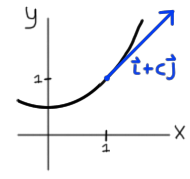Problem on finding a tangent vector to a curve
$\newcommand{\bfA}{\mathbf{A}}$
$\newcommand{\bfB}{\mathbf{B}}$
$\newcommand{\bfC}{\mathbf{C}}$
$\newcommand{\bfF}{\mathbf{F}}$
$\newcommand{\bfI}{\mathbf{I}}$
$\newcommand{\bfa}{\mathbf{a}}$
$\newcommand{\bfb}{\mathbf{b}}$
$\newcommand{\bfc}{\mathbf{c}}$
$\newcommand{\bfd}{\mathbf{d}}$
$\newcommand{\bfe}{\mathbf{e}}$
$\newcommand{\bfi}{\mathbf{i}}$
$\newcommand{\bfj}{\mathbf{j}}$
$\newcommand{\bfk}{\mathbf{k}}$
$\newcommand{\bfn}{\mathbf{n}}$
$\newcommand{\bfr}{\mathbf{r}}$
$\newcommand{\bfu}{\mathbf{u}}$
$\newcommand{\bfv}{\mathbf{v}}$
$\newcommand{\bfw}{\mathbf{w}}$
$\newcommand{\bfx}{\mathbf{x}}$
$\newcommand{\bfy}{\mathbf{y}}$
$\newcommand{\bfz}{\mathbf{z}}$
